Works
Nizami lived in an age of both political instability and intense intellectual activity, which his poems reflect; but little is known about his life, his relations with his patrons, or the precise dates of his works, as the many legends built up around the poet color the accounts of his later biographers. He dedicated his poems to various rulers of the region as was custom of that time for great poets, but avoided court life. Nizami was a master of the Masnavi style
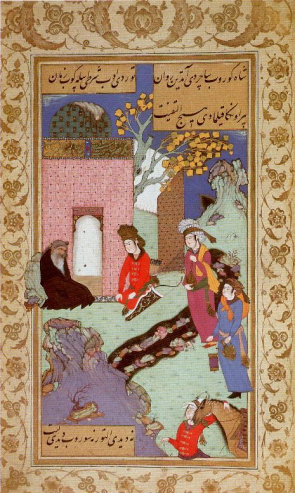
Makhzan-ol-Asrâr
The ethico-philosophical poems of about 2,250 Persian distichs was dedicated to Fakhr al-Din Bahramshah, the ruler of Erzinjan. The story deals with such esoteric subjects as philosophy and theology. The story contains twenty discourses, each of them portraying an exemplary story on religious and ethical topics. Each chapter concludes with apostrophe to the poet himself containing his pen name. The content of the poems are indicated in the heading to each chapter and are written in a typical Homiletics style. The stories which discuss spiritual and practical concerns enjoin kingly justice, riddance of hypocrisy, warning of vanity of this world and the need to prepare for the after-life. The general message of the discourse is that Nezami preaches the ideal way of life drawing attention to his reader of the supreme rank man among God's creatures and approaching of the end life and the necessity of man becoming aware of his spiritual destination. In a few chapters he address the duties of a king, but as a whole he addresses himself to mankind in general rather than to his royal patrons. In the introduction, the poet provides an account of his solitary vigils, called Khalwat. There is no indication that these were Sufi vigils, but they are used as a literary fantasy on the spiritually-inclined poet he wanted to be. In highly rhetorical style, the aim he pursues is to transcend the limitation of secular literature of the courts. With this work, Nezami joins the destination of Persian poetry, which had started with Sanai and was continued by others, in the first place by Attar.
Not a romantic epic, "The Treasury of Mysteries" was translated into English by Gholam H. Darab in 1945. After this early work, Nezami turned towards narrative poetry.
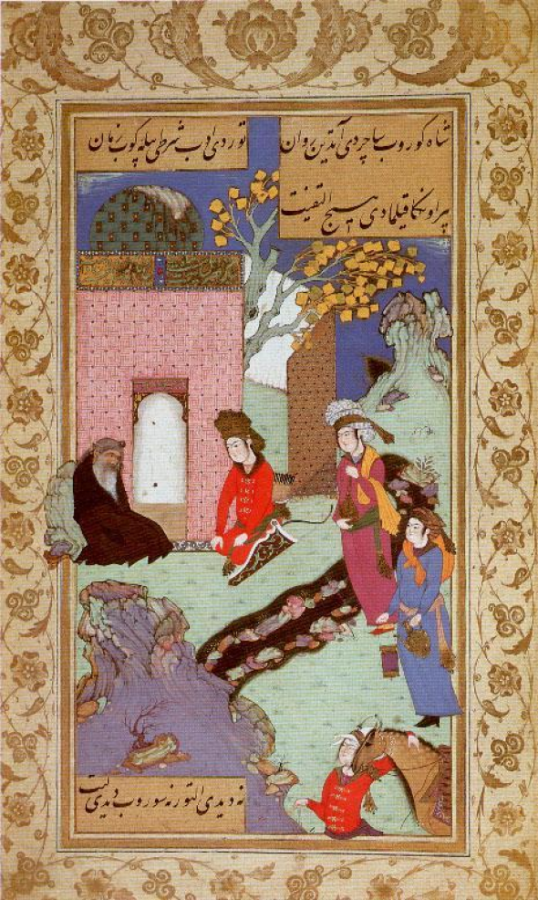
Khosrow o Shirin
TestA story of pre-Islamic Persian origin which is found in the great epico-historical poems of Shahnameh and is based on a true story that was further romanticized by Persian poets. The story chosen by Nezami, was commissioned and dedicated to the Seljuk Sultan Toghril II, the Atabek Muhammad ibn Eldiguz Jahan Pahlavan and his brother Qizil Arslan. It contains about 6,500 distichs in length, the story depicts the love of Sassanian Khosrow II Parviz towards his Armenian princess Shirin. Khusrow and Shirin recounts the story of King Khosrow's courtship of Princess Shirin, and the vanquishing of his love-rival, Farhad. The story has a complex structure with several genres exploited simultaneously; and contains many verbal exchanges and letters, all imbued with lyrical intensity. Khosrow endures long journeys, physical and spiritual, before returning to Shirin, his true love. They are eventually married, but finally Khosrow is killed by his son and Shirin commits suicide over the body of her murdered husband. Pure and selfless love is represented here embodied in the figure of Farhad, secretly in love with Shirin, who falls victim to the king's ire and jealousy.
The influence of Vis o Ramin is visible as the poem imitates a major scene (that of the lovers arguing in the snow) from Vis o Rāmin, as well as being in the same meter (hazaj) as Gorgāni's poem. Nezami's concern with astrology also has a precedent in an elaborate astrological description of the night sky in Vis o Rāmin. In turn, Nezami's great work had a tremendous influence on later authors and many imitations of this work were made. With complete artistic and structural unity, the epic of Khosrow o Shirin turned to be a turning point not only for Nizami but for all of Persian literature.
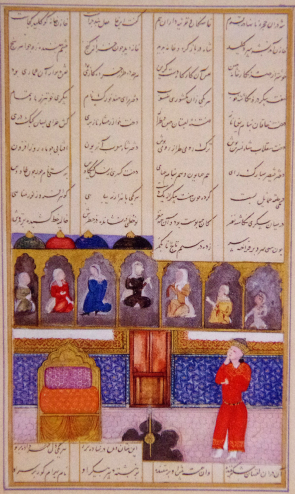
Leyli o Majnun
A story of Arabic origin which was later adapted and embellished by the Persians. The poem of 4,600 distichs was dedicated, in 1192, to Abu al-Muzaffar Shirvanshah, who claimed descent from the Sassanid King, whose exploits are reflected in Nezami's "Seven Beauties" (Haft Paykar). The poem is based on the popular Arab legend of ill-starred lovers: the poet Qays falls in love with his cousin Layla, but is prevented from marrying her by Layla's father. Layla's father forbids contact with Qays, so that Qays becomes obsessed and starts singing of his love for Layla in public. The obsession becomes so severe that he sees and evaluates everything in terms of Layla; hence his sobriquet "the possessed" (Majnun). Realizing that he cannot obtain union, even when other people intercede for him, he leaves society and roams naked in the desert among the beasts. However the image of Layla was so ingrained in him that he cannot eat or sleep. His only activity becomes composing poetry of longing for Layla. Meanwhile, Layla is married against her will, but she guards her virginity by resisting the advances of her husband. In a secret meeting with Majnun, they meet, but have no physical contact. Rather, they recite poetry to each other from a distance. Layla's husband dies eventually, which removes the legal obstacles to a licit union. However Majnun is so focused on the ideal picture of Layla in his mind, that he fled into the desert again. Layla dies out of grief and is buried in her bridal dress. Hearing this news, Majun rushes to her grave, where he instantly dies. They are buried side by side and their grave becomes a site of pilgrimage. Someone dreams that in Paradise they are united and live as a king and queen.
Nezami composed his romance at the request of the Shirvanshah Akhsatan. Initially, he doubted that this simple story about the agony and pain of an Arab boy wandering in rough mountains and burning deserts would be a suitable subject for royal court poetry and his cultured audience. It was his son who persuaded him to undertake the project, saying: "wherever tales of love are read, this will add spice to them". Nezami used many Arabic anecdotes in the story, but also adds a strong Persian flavor to the legend.
An important aspect of Layla and Majun is the poet's highly humanitarian approach. During the war by Nawfal in favor of Majnun, the latter is unhappy wishing the termination of the war. Majun gives away his horse and amours to save a gazelle and a stag.
Nezami gave a Persian character. to the poem by adding several techniques borrowed from the Persian epic tradition, such as the portrayal of characters, the relationship between characters, description of time and setting, etc. Further, he adapted the different stories about Majnun to fit a well-crafted Persian romantic epic.
The Story of Layla and Majnun by Nizami, was edited and translated into English by Swiss scholar of Islamic culture Rudolf Gelpke and published in 1966. A comprehensive analysis in English containing partial translations of Nezami's romance Layla and Majnun examining key themes such as chastity, constancy and suffering through an analysis of the main characters was published by Ali Asghar Seyed-Gohrab.
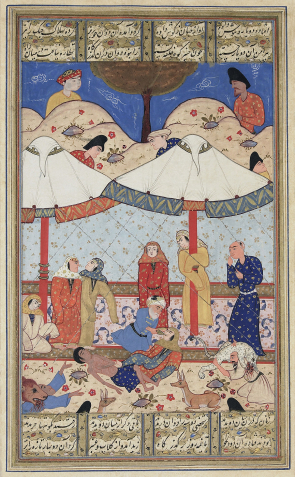
Eskandar-Nâmeh
The Romance of Alexander the Great contains 10,500 distichs. There are differences of opinion on whether this or the Haft Paykar was Nezami's last epic. The names of its dedicatees are uncertain, but the ruler of Ahar, Nosart al-Din Bishkin b. Mohammad has been mentioned. The story is based on Islamic myths developed about Alexander the Great, which derive from Qur'anic references to the Dhu'l-Qarnayn as well as from the Greek Alexander romance of Pseudo-Callisthenes. It consists of two books, Sharaf-Nama and Iqbal-nameh. The poem narrates the three stages in Alexander's life: first as the conqueror of the world; then as a seeker after knowledge, gaining enough wisdom to acknowledge his own ignorance; and finally as a prophet, traveling once again across the world, from west to east, and south to north to proclaim his monotheistic creed to the world at large. The Sharaf-nama discusses the birth of Alexander, his succession to the throne of Rum (Greece), his wars against Africans who invaded Egypt, his conquest of Persia and his marriage to the daughter of Darius. The episode also discusses Alexander's pilgrimage to Mecca, his stay in the Caucasus and his visit to Queen Nushaba of Barda' and her court of Amazons. Alexander conquers India, China and the land of the Rus. The Sharafnama concludes with Alexander's unsuccessful search for the water of immortal life.
The Iqbal-nameh is a description of Alexander's personal growth into the ideal ruler on a model ultimately derived, through Islamic intermediaries, from Plato's Republic. He has debates with Greek and Indian philosophers (c.f. with Garshaspnama) and a major portion of the text is devoted to the discourses he has with seven Greek sages. The poet then tells of Alexander's end and adds an account of the circumstances of the death of each of the seven sages. Nezami's image of Alexander is that of an Iranian knight.
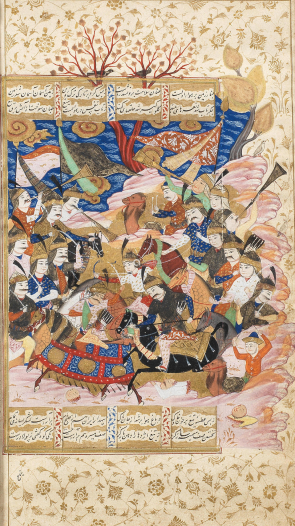
Haft Peykar
A pre-Islamic story of Persian origin, it was dedicated to the ruler of Maragha, 'Ala' Al-Din korp Arslan. It is the story of Bahram V, the Sassanid king, who is born to Yazdegerd after twenty years of childlessness and supplication to Ahura Mazda for a child. The Haft Peykar is a romanticized biography of the Sasanian Persian empire ruler Bahram Gur. His adventurous life had already been treated by Ferdowsi in the Shahnama, to which fact Nezami alludes a number of times. In general, his method is to omit those episodes that the earlier poet had treated, or to touch on them only very briefly, and to concentrate on new material. The poet starts by giving an account of the birth of Bahram Gur and his upbringing in the court of the Arab King No'man and his fabled palace Khwarnaq.
Bahram whose upbringing is entrusted to No'man becomes a formidable huntsman. While wandering through the fabled palace, he discovers a locked room which contains a depiction of seven princesses; hence the name Haft Peykar (seven beauties). Each of these princesses is from the seven different climes (traditional Zoroastrian-Islamic division of the Earth) and he falls in love with them. His father Yazdegerd I passes away and Bahram returns to Persia to claim his throne from pretenders. After some episodes he is recognized as King and rescues the Persians from a famine. Once the country is stable, the King searches for the seven princesses and wins them as his brides. His architect is ordered to construct seven domes for each of his new brides.
The architect tells him that each of the seven climes is ruled by one of the seven planets (classical planetary system of Zoroastrian-Islamic world) and advises him to assure good fortune by adorning each dome with the color that is associated with each clime and planet. Bahram is skeptical but follows the advice of the architect. The princesses take up residence in the splendid pavilions. On each visit, the king visits the princesses on successive days of the week; on Saturday the Indian princess, who is governed by Saturn and so on. The princesses names are Furak (Nurak), the daughter of the Rajah of India, as beautiful as the moon; Yaghma Naz, the daughter of the Khaqan of the Turks; Naz Pari, the daughter of the king of Khwarazm; Nasrin Nush, the daughter of the king of the Slavs; Azarbin (Azareyon), the daughter of the king of Morocco; Humay, the daughter of the Roman Caesar; and Diroste (wholesome), a beautiful Iranian princess from the House of Kay Ka'us. Each princess relates to the king a story matching the mood of her respective color.
These seven beautifully constructed, highly sensuous stories occupy about half of the whole poem. While the king is busy with the seven brides, his evil minister seizes power in the realm. Bahram Gur discovers that the affairs of Persia are in disarray, the treasury is empty and the neighboring rulers are posed to invade. He clears his mind first by going hunting. After returning from hunt, he sees a suspended dog from a tree. The owner of the dog, who was shepherd, tells the story of how his faithful watchdog had betrayed his flock to a she-wolf in return for sexual favors. He starts investigating the corrupt minister and from the multitude of complaints, he selects seven who tell him the injustice they have suffered. The minister is subsequently put to death and Bahram Gur restores justice and orders the seven pleasure-domes to be converted to fire temples for the pleasure of God. Bahram then goes hunting for the last time but mysteriously disappears. As a pun on words, while trying to hunt the wild ass (gūr) he instead finds his tomb (gūr).
Ritter, in his introduction to the critical edition describes it as: "the best and most beautiful epic in New Persian poetry and at the same time one of the most important poetical creations of the whole of oriental Indo-European literature". The Haft Peykar is considered the poet's masterpiece. Overall, Nezami illustrates the harmony of the universe, the affinity of the sacred and the profane, and the concordance of ancient and Islamic Iran
